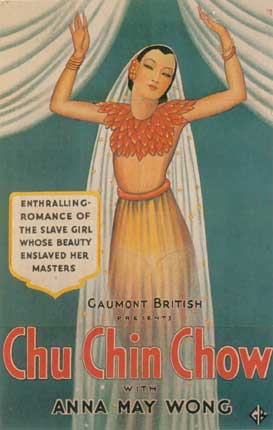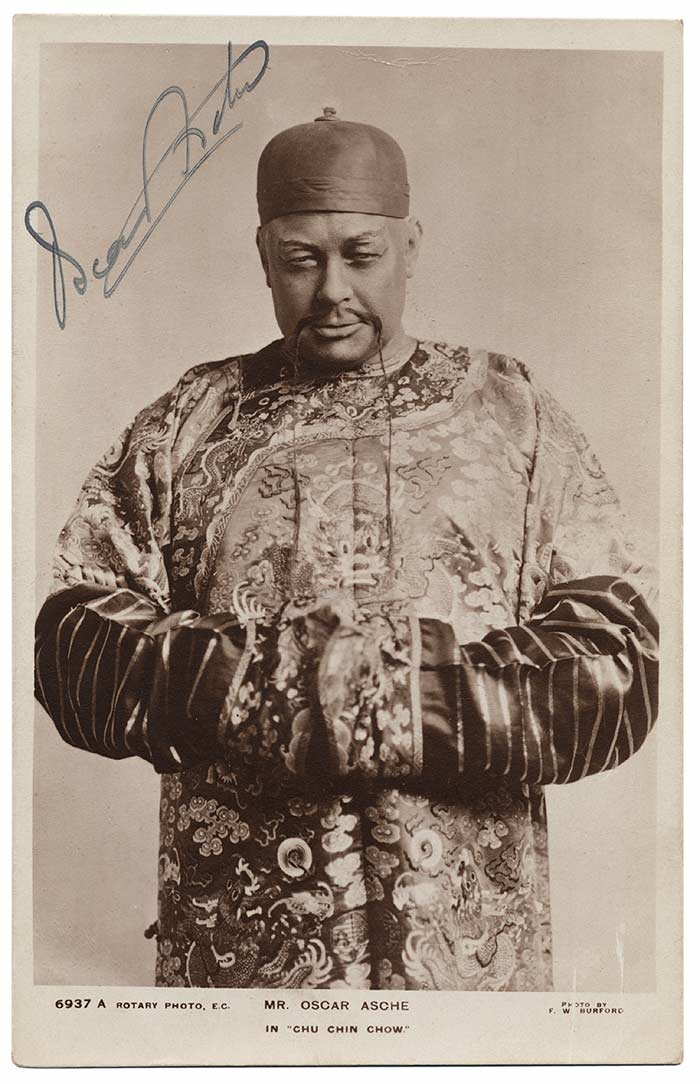Kurt Gänzl
The Encyclopedia of the Musical Theatre
9 July, 2016
Chu Chin Chow was a version of the Arabian Nights’ Ali Baba and the 40 Thieves tale, put together by actor, director and sometime playwright Asche as a vehicle for himself and his wife, actress Lily Brayton, and produced in wartime London at His Majesty’s Theatre on 31 August 1916 – in the theatre which normally housed the respected dramatic productions of Beerbohm Tree.

“Chu Chin Chow” movie poster, 1934.
Staged with a sumptuous extravagance, it proved to be one of the phenomena of the British stage of the early part of the century. The show’s initial London run of 2,235 performances set a London long-run record for a musical which survived for some forty years, and Chu Chin Chow went on to be an international hit in English-speaking theatres.
The robber chief Abu Hasan (Asche) is preparing to pull a coup in the home of the rich merchant Kasim Baba (Frank Cochrane), and the bandit’s beautful captive, Zahrat al-Kulub (Lily Brayton), has been introduced into the house, in the guise of a slave girl, to spy out the land. Ali Baba (Courtice Pounds), Kasim’s poor, layabout brother, accidentally discovers Hasan’s lair and the riches hidden there and, when the greedy Kasim goes to steal what he can from the hoard, he is captured and killed. Hasan plans to launch his attack on the late merchant’s household on the occasion of the wedding of Ali’s son Nur al-Huda (J.V. Bryant) and the slave girl Marjanah (Violet Essex), but Zahrat foils his plan and wins her revenge, disposing of Hasan’s men with the traditional boiling oil before stabbing the robber chief to death. Ali ends the evening in the well-padded arms of his brother’s widow, Alcolom (Aileen D’Orme).
Norton provided a score which included two numbers which became standards: Pounds and Miss D’Orme billed and cooed with comical, middle-aged passion to the strains of ‘Any Time’s Kissing Time,’ whilst the Cobbler (also Frank Cochrane, whose character had by then been killed off!) hired to sew the pieces of Kasim’s quartered body back together for burial sang of his trade in the bass-baritone Cobbler’s Song (‘I sit and cobble at slippers and shoon…’), a number which became a drawing-room and concert standard for half a century of low-voiced vocalists. Ali’s comical ‘When a Pullet is Plump (she’s tender),’ Nur al-Huda’s serenade ‘Corraline,’ the staunch march for the 40 thieves (‘We Are the Robbers of the Wood’) and Hasan’s disguised declaration ‘I Am Chu Chin Chow of China’ were other favorite moments of a score which also included a lot of incidental music to serve the show’s many scene changes (originally 15, later several more), parades and dances.
Amongst the several songs and scenes which were inserted during the show’s run, Miss D’Orme’s lovely, plaintive ‘I Long for the Sun’ was the most successful. The well-rounded soprano won her extra number through being one of the hits of the show, alongside Pounds – the keystone and real star of the evening – and the magnificent production values (scenery by Joseph and Phil Harker, costumes by Percy Anderson, director Asche, dances by Espinosa) whilst Asche and Miss Brayton provided the dramatic backbone to the entertainment with strong, melodramatic performances which complemented the comical ones ideally.

Costume designs for “Chu Chin Chow” as seen in the magazine “Tatler,” 1917.
The show was indeed ‘a beauty show – of scene and person, of dress and undress,’ but it also had a fine strong story, familiar and happy characters and characterizations, and attractive songs which helped to ensure its survival after that first lavish production. Grossmith and Laurillard took the show to the provinces with a cast headed by Bobbie Comber (Ali), Henry Latimer (Hasan) and Madge McIntosh (Zahrat), and Chu Chin Chow kept up a provincial presence in Britain for many years until, in 1940 (3 July), it was brought back to London for a second wartime run with the famous melodrama villain Lyn Harding as Hasan, Rosalinde Fuller as Zahrat, Jerry Verno as Ali, Kay Bourne as Alcolom, Dennis Noble as Nur al-Huda and with Sydney Fairbrother repeating her original rôle as Ali’s shrewish and ill-fated wife, Mahbubah.

Poster for the 1934 film “Chu Chin Chow,” starring Anna May Wong.
Chased from London by the bombs after 80 performances, it returned, partly recast, the following year for another 158 nights. In 1953 Chu Chin Chow was given as an ice-rink production at London’s Empire Pool, Wembley. Elliott, Comstock and Gest produced Chu Chin Chow in New York the year after its London opening. Tyrone Power (Hasan), Henry E Dixey (Ali), Florence Reed (Zahrat), Kate Condon (Alcolom) and Tessa Kosta (Marjanah) featured, the London designs were repeated, and Alexis Kosloff arranged new parades and dances for what looked like being another successful production. However, management went awry and, after a transfer, less than three months into the run, to the Century Theater, the expensively staged show closed after 208 performances, still in the red. It was left to a highly successful post-New York tour to recoup and add considerable profits to the producers’ outlay.

Oscar Asche in “Chu Chin Chow.”
The show returned briefly to the strike-brothered Broadway of 1919 (Century Theater 8 August, 33 performances) with Lionel Braham, Don Ferrandou and Marjorie Wood featured, and Eugene Cowles (Abdallah) and Albert Howson, of the famous Howson family (Kasim) in supporting rôles. Asche himself later took Chu Chin Chow to his native Australia, but only after Hugh D Mackintosh had already mounted a version there, with ex-Savoy star C H Workman (Ali), Vera Pearce (a Zahrat who sang better than any other female member of the cast!), Louie Pounds (Alcolom) and Maggie Moore (Mahbubah) amongst the cast and original cast member Frank Cochrane restaging Asche’s direction. Ward’s version played nearly three months in Melbourne before moving on to Sydney’s Grand Opera House (26 March 1921).

Poster for the 1923 film version of “Chu Chin Chow.”
Herbert Wilcox made a silent film version of Chu Chin Chow in 1923 but, after the coming of sound, a second version was made with George Robey starred as Ali Baba and Thelma Tuson as a richy funny Alcolom. Anna May Wong played the melodrama of Zahrat with conviction, whilst Fritz Kortner gave a burlesque stage performance as Hasan in what was, otherwise, one of the best filmed musicals of its time. Sydney Fairbrother and Frank Cochrane (just the cobbler this time) both put their unequalable original performances on celluloid.
USA: Manhattan Opera House 22 October 1917; Australia: Tivoli, Melbourne 11 December 1920; Belgium: (in French) Casino, Brussels August 1930; Films: Graham-Wilcox Films 1923 (silent), Gainsborough Films 1934

Did the immediate pre ww2 cast of Chu Chin Chow include two German born players Felix Slawinski and or Arno Franz Koehler (Kohler);if so in what capacity and what became of them. It seems that they were part of the 1939 Australian Tivoli tour and that they did not return to the UK before the outbreak of hostilities. Any help is much appreciated.